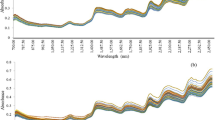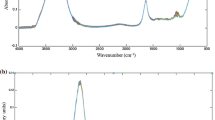Abstract
This paper reports on the development of an integrated leaf quality inspecting system using near infrared reflectance (NIR) spectroscopy for quick and in situ estimation of total polyphenol (TP) content of fresh tea leaves, which is the most important quality indicator of tea. The integrated system consists of a heating system to dry the fresh tea leaves to the level of 3–4% moisture, a grinding and sieving system fitted with a 250 micron mesh sieve to make fine powder from the dried leaf. Samples thus prepared are transferred to the NIR beam and TP is measured instantaneously. The wavelength region, the number of partial least squares (PLS) component and the choice of preprocessing methods are optimized simultaneously by leave-one-sample out cross-validation during the model calibration. In order to measure polyphenol percentage in situ, the regression model is developed using PLS regression algorithm on NIR spectra of fifty-five samples. The efficacy of the model developed is evaluated by the root mean square error of cross-validation, root mean square error of prediction and correlation coefficient (R2) which are obtained as 0.1722, 0.5162 and 0.95, respectively.




Similar content being viewed by others
References
Astill C, Birch BR, Dacombe C, Humphrey PG, Martin PT (2001) Factors Affecting the Caffeine and Polyphenol Contents of Black and Green Tea Infusions. J Agric Food Chem 49(11):5340–5347
Bedini A, Zanolli V, Zanardi S, Bersellini U, Dalcanale E, Suman M (2013) Rapid and simultaneous analysis of xanthines and polyphenols as bitter taste markers in bakery products by FT-NIR spectroscopy. Food Anal Methods 6(1):17–27
Bhuyan LP, Sabhapondit S, Barauh BD, Bordoloi C, Gogoi R, Bhattacharyya P (2013) Polyphenolic compounds and antioxidant activity of CTC black tea of North-East India. Food Chem 141(4):3744–3751
Bian M, Skidmore AK, Schlerf M, Fei T, Liu Y, Wang T (2010) Reflectance spectroscopy of biochemical components as indicators of tea (Camellia Sinensis) quality. Photogramm Eng Remote Sens 76(12):1385–1392
Chen Q, Zhao J, Zhang H, Wang X (2006) Feasibility study on qualitative and quantitative analysis in tea by near infrared spectroscopy with multivariate calibration. Anal Chim Acta 572(1):77–84
Chen Q, Zhao J, Chaitep S, Guo Z (2009) Simultaneous analysis of main catechins contents in green tea (Camellia Sinensis (L.)) by Fourier transform near infrared reflectance (FT-NIR) spectroscopy. Food Chem 113(4):1272–1277
Cooper R, Morre J, Morre MD (2005) Medicinal benefits of green tea: part I. Review of non-cancer health benefits. J Altern Complement Med 11(3):521–528
Eden T (1976) Tea. Tropical agriculture series, 3rd edn. Longman: London
Forrest GI, Bendall DS (1969) The distribution of polyphenols in the tea plant (Camellia sinensis L.). Biochem J 113(5):741–755
Gupta S, Saha B, Giri AK (2002) Comparative antimutagenic and anticlastogenic effects of green tea and black tea: a review. Mutat Res 512(1):37–65
Hall MN, Robertson A, Scotter CNG (1988) Near-infrared reflectance prediction of quality, theaflavin content and moisture content of black tea. Food Chem 27(1):61–75
Harbowy ME, Balentine DA (1997) Tea chemistry. Crit Rev Plant Sci 16(5):415–480
Hazarika A, Chanda S, Sabhapondit S, Sanyal S, Tamuly P, Tasrin S, Sing D, Naskar H, Tudu B, Bandyopadhyay R (2018) On-site estimation of total polyphenol in fresh tea leaf using near-infrared spectroscopy. NIR News 29(1):9–14. https://doi.org/10.1177/0960336017750326
He Y, Li XL, Deng XF (2007) Discrimination of varieties of tea using near-infrared spectroscopy by principal component analysis and BP model. J Food Eng 79(4):1238–1242
Huang H, Yu Haiyan Xu, Huirong Ying Y (2008) Near infrared spectroscopy for on/in-line monitoring of quality in foods and beverages: a review. J Food Eng 87(3):303–313
Jha SN, Matsuoka T (2004) Non-destructive determination of acid-brix ratio of tomato juice using near infrared spectroscopy. Int J Food Sci Technol 39:425–430. https://doi.org/10.1111/j.1365-2621.2004.00800.x
Jha SN, Ruchi G (2010) Non-destructive prediction of quality of intact apple using near infrared spectroscopy. J Food Sci Technol 47(2):207–213. https://doi.org/10.1007/s13197-010-0033-1
Kawasaki M, Kawamura S, Tsukahara M, Morita S, Komiya M, Natsuga M (2008) Near-infrared spectroscopic sensing system for on-line milk quality assessment in a milking robot. Comput Electron Agric 63(1):22–27. https://doi.org/10.1016/j.compag.2008.01.006
Kumar PVS, Basheen S, Ravi R, Thakur MS (2011) Comparative assessment of tea quality by various analytical and sensory methods with emphasis on tea polyphenols. J Food Sci Technol 48(4):440–446
Li X, Luo L, He Y, Xu N (2013) Determination of dry matter content of tea by near and middle infrared spectroscopy coupled with wavelet-based data mining algorithms. Comput Electron Agric 98:46–53. https://doi.org/10.1016/j.compag.2013.07.014
Li X, Sun C, Luo L, He Y (2015) Determination of tea polyphenols content by infrared spectroscopy coupled with IPLS and random frog techniques. Comput Electron Agric 112:28–35. https://doi.org/10.1016/j.compag.2015.01.005
Li ZX, Yang WJ, Ahammed GJ, Shen C, Yan P, Li X, Han WY (2016) Developmental changes in carbon and nitrogen metabolism affect tea quality in different leaf position. Plant Physiol Biochem 106:327–335. https://doi.org/10.1016/j.plaphy.2016.06.027
Luypaert J, Zhang MH, Massart DL (2003) Feasibility study for the use of near infrared spectroscopy in the qualitative and quantitative analysis of green tea. Camellia sinensis (L.). Analytica Chimica Acta 478(2):303–312
Mahanta PK (1988) Biochemical analysis as a measure of dynamic equilibrium in genomic set up during processing of tea. J Biosci 13(3):343–350
Obanda M, Owuor PO (1995) Impact of shoot maturity on chlorophyll content, composition of volatile flavour compounds and plain black tea chemical quality parameters of clonal leaf. J Sci Food Agric 69(4):529–534
Ozaki Y, McClure WF, Christy AA (2006) Near infrared spectroscopy in food science and technology. Wiley, ISBN: 978-0-470-04770-5. https://doi.org/10.1002/0470047704
Pereira VP, Knor FJ, Vellosa JCR, Beltrame FL (2014) Determination of phenolic compounds and antioxidant activity of green, black and white teas of Camellia sinensis (L.) Kuntze, Theaceae. Rev Bras Plantas Med 16(3):490–498. https://doi.org/10.1590/1983-084x/13_061
Pissard A, Beten V, Romnee JM, Dupont P, Mouteau A, Lateur M (2012) Classical and NIR measurements of the quality and nutritional parameters of apples: a methodological study of intra-fruit variability. Biotechnol Agron Soc Environ 16(3):294–306
Rakshit A (2016) India records highest ever tea production during the financial year 2015–2016. Business standard (Kolkata, India). [cited 2016 23:52 IST Jun 16]. https://www.business-standard.com/article/markets/india-records-highest-ever-tea-production-in-2015-16-116061700687_1.html
Ren G, Wang S, Ning J, Xu R, Wang Y, Xing Z, Wan X, Zhang Z (2013) Quantitative analysis and geographical traceability of black tea using Fourier transform near-infrared spectroscopy (FT-NIRS). Food Res Int 53(2):822–826
Roberts CA, Workman J Jr., Reeves JB III (2004) Near-infrared spectroscopy in agriculture, Agron Monogr, vol 44. ASA, CSSA, SSSA, Madison
Sabhapondit S, Bhuyan LP, Goswami BC, Hazarika M (2011) Seasonal and cultivar variation of catechin in North East Indian tea. Sci Cult 77:406–411
Sanderson GW (1972) The chemistry of tea and tea manufacturing. Recent Adv Phytochem 5(C):247–316. https://doi.org/10.1016/b978-0-12-612405-7.50015-1
Sanyal S (2011) Tea manufacturing manual. Tea Research Association, Tocklai Experimental Station, Jorhat. www.tocklai.net
Schulz H, Engelhardt UH, Wegent A, Drews HH, Lapczynski S (1999) Application of near-infrared reflectance spectroscopy to the simultaneous prediction of alkaloids and phenolic substances in green tea leaves. J Agric Food Chem 47(12):5064–5067
Sinija VR, Mishra HN (2009) FT-NIR spectroscopy for caffeine estimation in instant green tea powder and granules. LWT-Food Sci Technol 42(5):998–1002
Yen SH (2007) NIR evaluation of the quality of tea and its market price. Spectrosc Asia 3(2):12–15
Zhang D, Kuhr S, Engelhardt UH (1992) Influence of catechins and theaflavins on astringent taste of black tea brews. Z Lebensm Unters Forsch 195(2):108–111
Zhang MH, Luypaert J, Pierna JAF, Xu QS, Massart DL (2004) Determination of total antioxidant capacity in green tea by near-infrared spectroscopy and multivariate calibration. Talanta 62(1):25–35. https://doi.org/10.1016/S0039-9140(03)00397-7
Acknowledgements
The research work has been carried out in collaboration with Tocklai Tea Research Institute (TTRI), Jorhat, Assam, India. The work has been financially supported by National Tea Research Foundation (NTRF), India.
Author information
Authors and Affiliations
Corresponding author
Ethics declarations
Conflict of interest
The authors declare that they have no conflict of interest.
Electronic supplementary material
Below is the link to the electronic supplementary material.
Rights and permissions
About this article
Cite this article
Hazarika, A.K., Chanda, S., Sabhapondit, S. et al. Quality assessment of fresh tea leaves by estimating total polyphenols using near infrared spectroscopy. J Food Sci Technol 55, 4867–4876 (2018). https://doi.org/10.1007/s13197-018-3421-6
Revised:
Accepted:
Published:
Issue Date:
DOI: https://doi.org/10.1007/s13197-018-3421-6




